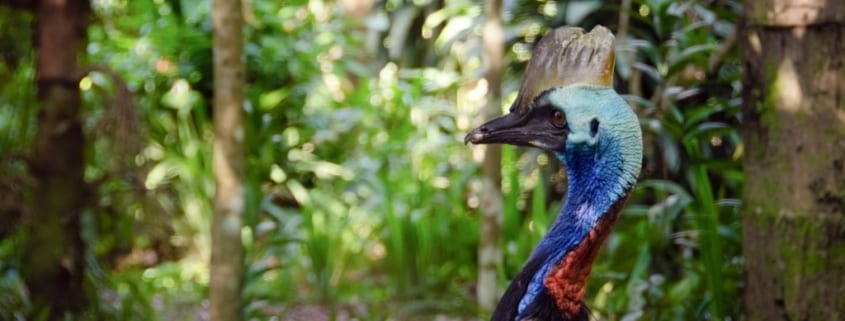Celebrating World Cassowary Day
World Cassowary Day, celebrated on September 24, highlights the importance of these threatened birds to rainforest ecosystems.
Combine two Papuan words—“kasu,” meaning horned, and “weri,” referring to head— and you get the name as well as description of one of the largest birds on earth. The shape and markings of the cassowary’s helmet-like casque are unique to each individual, and may serve as an acoustic amplifier for the birds’ low frequency calls. These flightless black birds with vibrant blue necks are related to ostriches and emus, and they are found in the rainforests of northeastern Australia, neighboring New Guinea and surrounding islands.
As territorial birds, cassowaries prefer their own personal space and will primarily stay within their home ranges throughout the year, unless it is mating season or there is a food shortage. Each cassowary foot has dagger-like claws that can grow up to five inches long—a warning to potential threats and resource competitors that they won’t shy away from a fight when provoked.
Cassowaries also use their claws to forage for fruit that has fallen to the forest floor. These birds mainly eat fruit, though they do consume small vertebrates, invertebrates, fungi and carrion as well. Once a cassowary consumes fruit, the seeds continue through its digestive track and are released back into the rainforest in natural fertilizer. Because the birds can travel significant distances before the seeds are expelled, cassowaries distribute them throughout their range—making them gardeners and architects of the rainforest.
Unfortunately, their ranges are being encroached upon, to the detriment of both the environment and the species that depend on it. Due to the destruction and fragmentation of their rainforest habitats in Australia, Southern Cassowaries are classified as Vulnerable on the IUCN Red List of Threatened Species. Because of the symbiotic relationship between cassowaries and the forest— the plants provide food and habitat, the birds ensure its continued growth through seed distribution— to protect one is to preserve the other. By helping safeguard Daintree National Park and the Atherton Tablelands, Rainforest Trust works to ensure that these stunning ecosystems and the cassowaries that call them home flourish for generations to come.
This World Cassowary Day, help save these charismatic birds by protecting their unique habitats in Daintree National Park if you are in the US, or both Daintree National Park and the Atherton Tablelands if you reside in Australia.
Header photo: Southern Cassowary in the Daintree Rainforest. Photo courtesy of AAWE_19.




